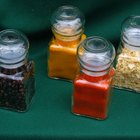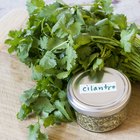
The North Dakota State University Extension Service Food Storage Guide states that whole spices expire in 1 to 2 years from manufacture, and ground spices and herbs expire 6 months from manufacture. However, most cooks know that herbs, spices and seasonings can be useful beyond that time frame: after all, the shelf life of these pantry staples depends on a variety of factors, such as packaging, storage temperature and exposure to moisture and heat. Using a few tricks, you can establish which elements of your pantry arsenal are still useful and which should be replaced.
Check the Color

With spices, what you see is generally what you get. With most spices, bright, crisp color means bright, crisp taste. If the spice's color has changed or dulled, it often means that the seasoning has lost flavor due to evaporation of essential oils. For instance, if the spice started out green, like parsley or dill, it will turn brown as the essential oils dissipate. Similarly, red spices, like paprika or chili, will darken.
Check the Texture

Moisture adversely affects all dry spices. Moisture causes easy-to-spot textural changes, causing the particles to stick together in clumps, and speeding the loss of essential oils. Unfortunately, since using shakers over steaming food is commonplace, moisture enters most spice containers. If your spice or seasoning is clumpy, it should be replaced. If you do still wish to use what's inside, access it only with a dry spoon, and never over a cooking meal.
Check the Smell
The essential oils that give spices vibrant flavor are always aromatic. As such, the aroma of an unexpired spice or seasoning is distinct. To test the viability of a spice, rub a pinch between warm fingers and take a whiff; if you don’t smell anything, the flavorful oils have dissipated, and the spice will not impart much flavor to food.
Check the Label

While some spices and seasonings are marked with expiration dates, many are not. As a rule, if a label looks old, the label is either greater than two years old or it has been likely exposed to moisture, light or heat that has adversely affected the spice inside. Some tricks help identify spice packaging. For instance, all spices marked with a “Schilling” label are older than their 1 to 2 year expiration date.
Related Articles

How to Keep Moisture Out of My Spices

Do Seasoning Blends Go Bad?

Does Dry Chili Ever Expire?

How to Remove Cigarette Smoke Stains

How to Repair Heat Damaged Leather

Can Bugs Grow in Spices Such As Paprika?

How to Cook Okra in the Microwave
Longest Lasting Supermarket Foods for ...

How to Make Dried Meat

What to Use in Place of Italian ...

Rayon Spandex Care Instructions

How to Brighten Colored Clothes

Can You Still Use Basil That Goes a ...

How to Dry Cilantro at Home

How to Cook With Rice Wine

How to Clean a Suede Handbag
Maximum Storage Temperature of Canned ...

What Happens If You Eat Expired Brown ...

How to Prevent Fabric Dry Rot
How to Salt and Dry Pistachios
References
- North Dakota State University Extension Service: Food Storage Guide
- "The Joy of Cooking;" Irma S. Rombauer, Marion Rombauer Becker, Ginnie Hofmann & Ikki Matsumoto; 1985
Writer Bio
Annette O'Neil is an air sports athlete, digital nomad, full-time traveler and yogini. A writer for more than a decade, O'Neil has written copy, content and editorial articles for hundreds of clients and publications, including Blue Skies Magazine and Whole Life Times.
Photo Credits
BananaStock/BananaStock/Getty Images